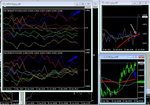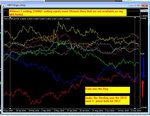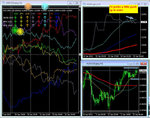No FT no comment :-
literally Billions of Pounds are spent paying experts to predict the future......with so many variables its still a lottery so dont worry about it, just trade what you see :smart:
oh yeah - and also carry a dictionary perhaps 😛
I have to agree though the Euro looks a pup and you'd have to give me some serious odds to back it to be higher in relative terms to G8 this time next year
Euro looks set to win the race to the bottomBy Kenneth Rogoff
Published: January 12 2011 15:33 | Last updated: January 12 2011 15:33
Currency movements are notoriously difficult to explain, much less predict. Even so, 2010 was an exceptionally tough year. Foreign exchange participants were forced to divine idiosyncratic and conflicting policymaker preferences, to interpret rare events such as Europe’s sovereign debt woes, and to understand obscure policy instruments such as quantitative easing.
The euro/dollar rate, for example, fell from $1.45 to $1.20 in the first half of 2010, only to rise again to over $1.40 in November, before briefly dropping below $1.30 again in its current swoon. Some of this volatility can be ascribed to shifting growth data across the Atlantic. But other less concrete factors, such as Europe’s bogus bank stress tests and investor unease with the Fed’s quantitative easing, seemed to play a larger role. Whenever the favoured market explanation of a big exchange rate movement is “the Chinese are buying”, one has to wonder whether exchange rates have any anchor in long-term macroeconomic fundamentals.
Eurozone macroeconomic policy is incoherent on so many levels, it is hard to know where to begin. The basic strategy is to hope that fiscal tightening in the periphery combined with generous liquidity relief from the core will solve all ills. The only problem is that the populations of Greece, Ireland, Portugal and perhaps Spain, cannot be asked to suffer recession indefinitely so that foreign creditors can be repaid. Rather than contemplate reintroducing the drachma, the eurozone decided to celebrate the new year by taking in Estonia. Estonia is a great country, and it deserves a lot of support. I grew up on Estonian grandmaster Paul Keres’ chess books. But did it really make sense to add another emerging market at this time?
Then there is China and its quasi-fix to the dollar. At one time, China’s policy might have made perfect sense, but today the case for high growth China pegging to low growth US is hard to sustain. China’s peg engenders a plethora of distortions, tilting the economy towards export production and away from output for the domestic market. True, China has not yet experienced the sustained inflation, as it might if its real (inflation-adjusted) exchange rate truly was way out of line.
Inflation, however, seems to be taking root in a fashion that could force authorities to act much more decisively, with increasingly few alternatives to allowing a straightforward appreciation of the currency. Indeed, many fast-growing emerging markets such as Brazil and India are confronting much the same problem. They do not want their currencies to rise too quickly against the dollar, but their central banks do not want inflation to get out of hand.
How emerging markets resolve these conflicting goals will be a central theme in foreign exchange markets in 2011. Talk of “currency wars” will continue to be accompanied by ever more stringent capital controls. Look for a resurgence of the kind of parallel exchange markets that ruled the globe in the 1950s and early 1960s. In my work with Carmen Reinhart on the history of exchange rate arrangements, we found that in a great many cases, parallel markets allowed many countries a degree of floating even when the official exchange rate was fixed. This is the mirror image of the modern phenomenon whereby many countries that officially have floating rates in fact are better thought of as having pegs.
Finally, there are developed country commodity exporters such as Canada, Australia and New Zealand, whose currencies are likely to continue to appreciate as long as emerging markets continue to thrive, even with their policy inconsistencies.
All in all, 2011 is shaping up as a race to the bottom for currency values. In this currency war, does any country truly want to be the victor? No wonder gold has been so attractive. Which currency will succeed in hugely underperforming in 2011? Recognising the near impossibility of predicting exchange rates, my “money” is still on the euro. I am cautiously optimistic that Europe will find a way to manage its country bankruptcies, but there are no elegant solutions, and the possibility of political paralysis at just the wrong time is significant. The US’s quantitative easing policy may be obscure and some may see it as cause for alarm. There is a small chance of large catastrophe. But the eurozone, by contrast, has a high chance of a medium-size meltdown. The single currency may win the race to the bottom after all.
Kenneth Rogoff is a professor at Harvard University and co-author (with Carmen Reinhart) of ‘This Time is Different: Eight Centuries of Financial Folly’










